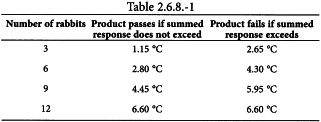Appendix XIV D. Test for Pyrogens
The test consists of measuring the rise in body temperature evoked in rabbits by the intravenous injection of a sterile solution of the substance to be examined.
Selection of animals
Use healthy, adult rabbits of either sex weighing not less than 1.5 kg, fed a complete and balanced diet not containing antibiotics, and not showing loss of body mass during the week preceding the test. A rabbit is not to be used in a pyrogen test if:
Animals’ quarters
Keep the rabbits individually in a quiet area with a uniform appropriate temperature. Withhold food from the rabbits overnight and until the test is completed; withhold water during the test. Carry out the test in a quiet room where there is no risk of disturbance exciting the animals and in which the room temperature is within 3 °C of that of the rabbits′ living quarters, or in which the rabbits have been kept for at least 18 h before the test.
Materials
Thoroughly wash all glassware, syringes and needles with water for injections and heat in a hot-air oven at 250 °C for 30 min or at 200 °C for 1 h.
Retaining boxes
The retaining boxes for rabbits whose temperature is being measured by an electrical device are made in such a way that the animals are retained only by loosely fitting neck-stocks; the rest of the body remains relatively free so that the rabbits may sit in a normal position. They are not restrained by straps or other similar methods that may harm the animal. The animals are put into the boxes not less than 1 h before the 1st recording of the temperature and remain in them throughout the test.
Thermometers
Use a thermometer or electrical device that indicates the temperature with a precision of 0.1 °C and insert into the rectum of the rabbit to a depth of about 5 cm. The depth of insertion is constant for any 1 rabbit in any 1 test. When an electrical device is used it may be left in position throughout the test.
Preliminary test
After selection of the animals, 1-3 days before testing the product to be examined, treat those animals that have not been used during the previous 2 weeks by intravenous injection of 10 mL per kilogram of body mass of a pyrogen-free 9 g/L solution of sodium chloride R warmed to about 38.0 °C. Record the temperatures of the animals, beginning at least 90 min before injection and continuing for 3 h after the injection of the solution. Any animal showing a temperature variation greater than 0.6 °C is not used in the main test.
Main test
Carry out the test using a group of 3 rabbits.
Preparation and injection of the product Warm the liquid to be examined to approximately 38.0 °C before the injection. The product to be examined may be dissolved in, or diluted with, a pyrogen-free 9 g/L solution of sodium chloride R or another prescribed liquid. Inject the solution slowly into the marginal vein of the ear of each rabbit over a period not exceeding 4 min, unless otherwise prescribed in the monograph. The amount of the product to be injected varies according to the product to be examined and is prescribed in the monograph. The volume injected is not less than 0.5 mL per kilogram and not more than 10 mL per kilogram of body mass.
Determination of the initial and maximum temperatures The ‘initial temperature’ of each rabbit is the mean of 2 temperature readings recorded for that rabbit at an interval of 30 min in the 40 min immediately preceding the injection of the product to be examined. The ‘maximum temperature’ of each rabbit is the highest temperature recorded for that rabbit in the 3 h after the injection. Record the temperature of each rabbit at intervals of not more than 30 min, beginning at least 90 min before the injection of the product to be examined and continuing 3 h after the injection. The difference between the maximum temperature and the initial temperature of each rabbit is taken to be its response. When this difference is negative, the result is counted as a zero response.
Rabbits showing a temperature variation greater than 0.2 °C between 2 successive readings in the determination of the initial temperature are withdrawn from the test. In any 1 test, only rabbits having initial temperatures that do not differ from one another by more than 1 °C are used. All rabbits having an initial temperature higher than 39.8 °C or less than 38.0 °C are withdrawn from the test.
Interpretation of results
Having carried out the test 1st on a group of 3 rabbits, repeat if necessary on further groups of 3 rabbits to a total of 4 groups, depending on the results obtained. If the summed response of the 1st group does not exceed the figure given in the 2nd column of Table 2.6.8.-1, the substance passes the test. If the summed response exceeds the figure given in the 2nd column of the table but does not exceed the figure given in the 3rd column of the table, repeat the test as indicated above. If the summed response exceeds the figure given in the 3rd column of the table, the product fails the test.
Rabbits used in a test for pyrogens where the mean rise in the rabbits’ temperature has exceeded 1.2 °C are permanently excluded.
In accordance with the provisions of the European Convention for the Protection of Vertebrate Animals used for Experimental and Other Scientific Purposes, tests must be carried out in such a way as to use the minimum number of animals and to cause the least pain, suffering, distress or lasting harm. Wherever possible and after product-specific validation, the pyrogen test is replaced by the monocyte-activation test (2.6.30).
